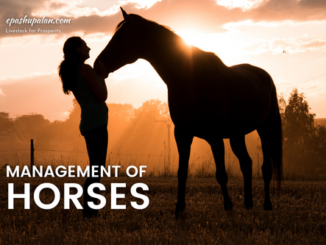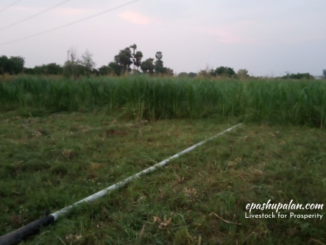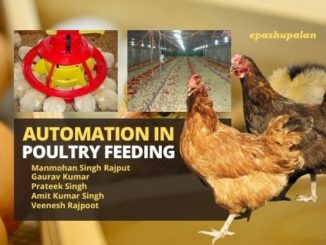Feeding of horse is an art as well as a science. After food is digested, blood carries its energy to the body. Energy nutrients power muscle movement to walk, breathe and blink eyes. Horses devote more time to eating than to any other behavioral activity. Behavior has direct effects on consumption patterns and the selection of feeds. The time a horse spends consuming feed is controlled by a number of factors. Grazing time depends primarily on type and availability of forage, consumption behavior and level of nutrient demand. Horses are the group of animals, referred as hind gut fermenter. They process and ingest that component of feed which cannot digested be by small intestine. When feeding horses, it is important to recognize that there are five basic nutrient categories that must be met: carbohydrate, protein, vitamins, minerals and water.

The first four components can be made available by feed company in balanced form but we should not neglect the water consumption. It makes up most of the blood that carries nutrients to cells and takes waste products away. In addition, water is the body’s built-in cooling system; it regulates body heat. Water requirement of an animal depends on the type of feed, temperature, humidity and activity level of that particular animal. A horse drinks about 38 to 45 liter of water daily depending on the work it is doing. In hot weather, a horse may drink up to 57 to 76 liter of water. In very cold weather, water heaters may be needed to prevent the water from freezing. Clean water should be provided daily, should be available at all times for the horse to drink when it is thirsty. If this is not possible, horses should be watered a minimum of twice daily and allowed several minutes to drink each time. Horses that do not drink enough water are more susceptible to conditions such as dehydration and impactions.
Carbohydrates
Carbohydrates are the main energy source. Horses can digest grass and hay because they have small microbes in their large intestine that can break it down. This is why horses get so much nutritional value from grass and hay. It is important to feed good quality hay that is free of mold and dust and is cut at an appropriate length and stage of maturity. Hay that has too coarse a stem or hay that is too fine can cause digestive problems such as impactions. Most nutrients in hay are in the leaves, and leafy hay is a valuable source of food. Horse’s digestive system evolved to process a roughage-based diet; therefore, concentrates should be used only to supplement the forage program and meet nutritional requirements that cannot be met by forage alone. Concentrates are lower in fiber and higher in energy than roughages. Grains may be cracked, steamed or rolled, but, if ground too finely, may cause respiratory problems or colic. Excessive intake of grain contributes to development of diarrhea, colic and/or laminitis. Horses require 20g/ kg/ day feed on dry matter basis. Roughages should contain minimum 70 per cent of horse diet on dry matter basis. Hay can either be leguminous or non-leguminous. Most commonly fed roughages are Alfalfa hay, oats hay and soybean hay while most commonly fed concentrates are Oats, Barley, Wheat, maize, Wheat bran etc. Oats are the safest and easiest grain to feed with hay because it is high in fiber and low in energy, and higher in protein than corn. Maize has the highest energy content of any grain and can put weight on a horse quickly. Occasionally these grains can cause impaction or colic if they are fed alone or if they are eaten too fast by greedy horses. Feeding of wheat straw has been found to be the major risk factor associated with impaction in horse. Fat is an excellent and easily digestible source of energy. Energy in fat is more concentrated than energy in carbohydrates. It should never be more than 10% of the diet.
Protein
Protein, which is necessary for body growth and maintenance, is a nutrient that is poorly understood by many horse owners. Protein requirements for growth and maintenance vary depending on age and workload. Proteins in the body make up muscle, internal organs, bone and blood. Skin, hair, hooves and many other parts of a horse also are made of protein. Mature horses will most likely need 8 to 12 percent of protein. A growing horse generally needs between 12 and 18 percent crude protein in its diet for proper growth and development. Horses that are in intense training need more protein than the maintenance horse most will do well on a 12 percent protein feed. In general, legume hays are higher in protein than grass hays. Good quality legume hay can have roughly 18 to 22 percent crude protein, while good quality grass hay can have 10 to 16 percent crude protein. Supplemental protein sources are linseed meal and soybean meal can be added to grass hay and grains. Legume hays such as alfalfa are also good protein sources. The average ration should contain approximately 12 percent crude protein.
Vitamins
Vitamins are needed in much smaller amounts than other nutrients, but they are just as vital. Vitamin A is important in maintaining the skin and epithelial linings of the digestive, respiratory, urinary, and reproductive tracts. Vitamin D is especially important for normal bone growth and maintenance. Vitamin E is often associated with improved reproduction and muscle maintenance. Under conditions of barn confinement or feeding poor-quality forage, economical supplements of these vitamins can be mixed in the feed, injected intramuscularly, or furnished in stabilized mineral blocks. A good forage program combined with a well-formulated concentrate will provide adequate vitamins to meet your horse’s requirements.
Minerals
Minerals are another item that can be found in supplements on feed. Mineral needs will change depending on your horse’s age and status. Most horses need extra calcium, phosphorus, salt, and possibly some trace minerals such as iron, copper, zinc, manganese, iodine, and selenium. Without iron, blood cannot carry oxygen to the body’s cells. Without calcium and phosphorous, bones and teeth will not form properly .The calcium requirement is 0.3 percent dietary calcium for fully mature horses. The phosphorus requirement may range from 0.2 percent dietary phosphorus for fully mature horses to 0.6 percent in weanling foals. The calcium and phosphorus needs of mares in early lactation are approximately double those of mature horses that are not providing milk for foals. A calcium-to-phosphorus ratio of 1:1 should be provided for young horses. Older horses can usually tolerate a higher ratio, possibly one as high as 6:1. There should not be more phosphorus than calcium in a horse’s diet. Biotin, zinc and copper supplemented above requirements have been shown to improve hoof strength. A good way to furnish supplemental minerals is to offer a free choice mixture of equal parts of di-calcium phosphate and trace-mineralized salt in a box protected from the weather. In formulating complete mixed hay and grain rations, about 1 per cent di-calcium phosphate and 0.5 per cent trace-mineralized salt should be added.
Feeding of horse varies between countries and states. The basic category remains the same but the ingredient changes as per availability of feedstuffs. Tradition also plays a major role in ingredient. That’s why most horse owner use a limited number of feedstuffs and is reluctance to try alternative. Horse should be fed as per their physiological state, body weight and their utility.






India have a lot of equine population. Most of the equines are reared without any knowledge about the horse requirements. This work will help on extension workers as well as field vets to make feeding recomendations.
very informative article.